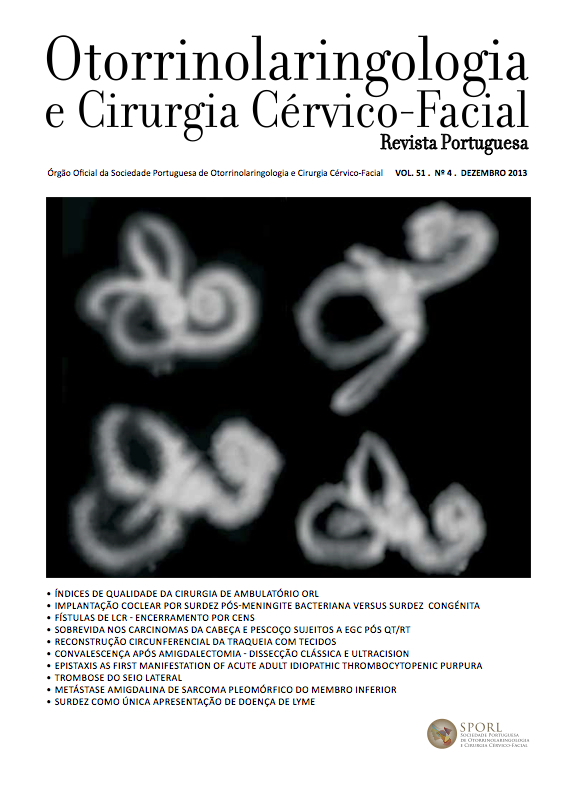Epidemiology of deep neck infection submitted to surgery in a portuguese tertiary hospital centre
DOI:
https://doi.org/10.34631/sporl.2081Keywords:
Deep Neck Infection, MediastinitisAbstract
Objective: Assess epidemiological data and clinical predictors of mediastinitis in deep neck infections (DNI) submitted to surgery.Study Design: Retrospective observational
Methods: Data analysis of every DNI patient submitted to surgery from January 2015 to December 2021 in the Otorhinolaryngology department of a tertiary hospital center.
Results: A total of 165 patients with a mean age of presentation of 48,5 years were included. The most frequent etiology was odontogenic infection (51,5%) and the most involved cervical space was the submandibular space (60,6%). Furthermore, the most isolated bacteria in patients with and without mediastinitis was Streptococcus spp. Progression to mediastinitis occurred in 20 (12,1%) patients. In a multivariate analysis, a bilateral DNI location (p=0,015) and a higher neutrophil to lymphocyte ratio (NLR) (0,037) were associated with progression to mediastinitis.
Conclusion: The presence of a bilateral DNI and NLR seem to be the most important clinical predictors of mediastinitis.
Downloads
References
Russell MD, Russell MS. Urgent infections of the head and neck. Med Clin North Am. 2018 Nov;102(6):1109-1120. doi: 10.1016/j.mcna.2018.06.015.
Prado-Calleros HM, Jiménez-Fuentes E, Jiménez-Escobar I. Descending necrotizing mediastinitis: systematic review on its treatment in the last 6 years, 75 years after its description. Head Neck. 2016 Apr;38 Suppl 1:E2275-83. doi: 10.1002/hed.24183.
Reynolds SC, Chow AW. Life-threatening infections of the peripharyngeal and deep fascial spaces of the head and neck. Infect Dis Clin North Am. 2007 Jun;21(2):557-76, viii. doi: 10.1016/j.idc.2007.03.002.
Kimura A, Miyamoto S, Yamashita T. Clinical predictors of descending necrotizing mediastinitis after deep neck infections. Laryngoscope. 2020 Nov;130(11):E567-E572. doi: 10.1002/lary.28406.
Ma C, Zhou L, Zhao JZ, Lin RT, Zhang T, Yu LJ. et al. Multidisciplinary treatment of deep neck infection associated with descending necrotizing mediastinitis: a single-centre experience. J Int Med Res. 2019 Dec;47(12):6027-6040. doi: 10.1177/0300060519879308.
Trevino-Gonzalez JL, Maldonado-Chapa F, Gonzalez-Larios A, Morales-Del Angel JA, Soto-Galindo GA, Zafiro Garcia-Villanueva JM. Deep neck infections: demographic and clinical factors associated with poor outcomes. ORL J Otorhinolaryngol Relat Spec. 2022;84(2):130-138. doi: 10.1159/000517026.
Adovica A, Veidere L, Ronis M, Sumeraga G. Deep neck infections: review of 263 cases. Otolaryngol Pol. 2017 Oct 30;71(5):37-42. doi: 10.5604/01.3001.0010.5315.
Mejzlik J, Celakovsky P, Tucek L, Kotulek M, Vrbacky A, Matousek P. et al. Univariate and multivariate models for the prediction of life-threatening complications in 586 cases of deep neck space infections: retrospective multi-institutional study. J Laryngol Otol. 2017 Sep;131(9):779-784. doi: 10.1017/S0022215117001153.
Chi TH, Tsao YH, Yuan CH. Influences of patient age on deep neck infection: clinical etiology and treatment outcome. Otolaryngol Head Neck Surg. 2014 Oct;151(4):586-90. doi: 10.1177/0194599814542589.
Hidaka H, Yamaguchi T, Hasegawa J, Yano H, Kakuta R, Ozawa D. et al. Clinical and bacteriological influence of diabetes mellitus on deep neck infection: Systematic review and meta-analysis. Head Neck. 2015 Oct;37(10):1536-46. doi: 10.1002/hed.23776.
Brajkovic D, Zjalić S, Kiralj A. Prognostic factors for descending necrotizing mediastinitis development in deep space neck infections-a retrospective study. Eur Arch Otorhinolaryngol. 2022 May;279(5):2641-2649. doi: 10.1007/s00405-021-07081-0.
Zahorec R. Neutrophil-to-lymphocyte ratio, past, present and future perspectives. Bratisl Lek Listy. 2021;122(7):474-488. doi: 10.4149/BLL_2021_078.
Tan M, Lu Y, Jiang H, Zhang L. The diagnostic accuracy of procalcitonin and C-reactive protein for sepsis: a systematic review and meta-analysis. J Cell Biochem. 2019 Apr;120(4):5852-5859. doi: 10.1002/jcb.27870.
Downloads
Published
How to Cite
Issue
Section
License
Copyright (c) 2023 The authors retain copyright of this article.

This work is licensed under a Creative Commons Attribution-ShareAlike 4.0 International License.






